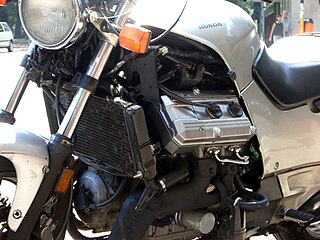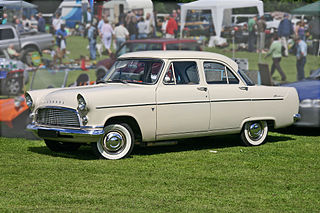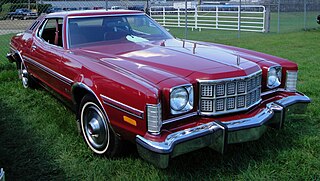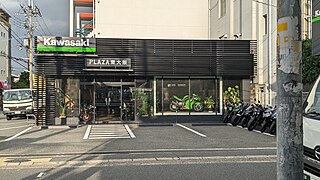Bombardier Inc. is a Canadian business jet manufacturer. Headquartered in Montreal, the company was founded in 1942 by Joseph-Armand Bombardier to market his snowmobiles and became one of the world's biggest producers of aircraft and trains.

Aprilia is an Italian motorcycle manufacturer founded immediately after World War II in Noale, Italy, by Alberto Beggio. The company started as a manufacturer of bicycles and moved on to manufacture scooters and small-capacity motorcycles. Since in the 1980s, Aprilia has also produced large sportbikes such as the 1,000 cc V-twin RSV Mille and the V4 RSV4.

A V4 engine is a four-cylinder piston engine where the cylinders share a common crankshaft and are arranged in a V configuration.

A snowmobile, also known as a snowmachine, motor sled, motor sledge, skimobile, or snow scooter, is a motorized vehicle designed for winter travel and recreation on snow.

Sea-Doo is a Canadian brand of personal watercraft (PWC) and boats manufactured by Bombardier Recreational Products (BRP). All Sea-Doo models are driven by an impeller-driven waterjet. All Sea-Doo PWC models are produced at BRP's plants in Querétaro and Juárez, Mexico. Its Rotax engines are produced at BRP's plant in Gunskirchen, Austria. In 2016, Sea-Doo had a 45.8% share of the PWC market.
Rotax is the brand name for a range of internal combustion engines developed and manufactured by the Austrian company BRP-Rotax GmbH & Co KG, in turn owned by the Canadian Bombardier Recreational Products (BRP). Under the Rotax brand, the company is one of the world's largest producers of light piston engines.

Joseph-Armand Bombardier was a Canadian inventor and businessman who was the founder of Bombardier. His most famous invention was a snowmobile.

BRP Inc. is a Canadian manufacturer of snowmobiles, all-terrain vehicles, side by sides, motorcycles, and personal watercraft. It was founded in 2003, when the Recreational Products Division of Bombardier Inc. was spun off and sold to a group of investors consisting of Bain Capital, the Bombardier-Beaudoin family and the Caisse de dépôt et placement du Québec. Bombardier Inc., was founded in 1942 as L'Auto-Neige Bombardier Limitée by Joseph-Armand Bombardier at Valcourt in the Eastern Townships, Quebec.

The Ford Consul Classic is a mid-sized car that was launched in May 1961 and built by Ford UK from 1961 to 1963. It was available in two or four door saloon form, in Standard or De Luxe versions, and with floor or column gearshift. The name Ford Consul 315 was used for export markets. The Ford Consul Capri was a 2-door coupé version of the Classic, and was available from 1961 until 1964.

The Ford Fairmont is a model line of compact cars that was manufactured by Ford from the 1978 to 1983 model years. The successor of the Ford Maverick, the Fairmont marked the third generation of compact sedans sold by Ford in North America. Initially slotted between the Pinto and Granada within the Ford line, the Fairmont was later marketed between the Ford Escort and Ford LTD. In contrast to its predecessor, the model line was offered as a two-door notchback sedan, two-door coupe, four-door sedan, and five-door station wagon. Though never sold as a Lincoln, Mercury sold a divisional counterpart of the Fairmont as the Mercury Zephyr.

The Ford Consul is a car that was manufactured by Ford of Britain from 1951 until 1962. The name was later revived for a model produced by Ford in both the UK and in Germany from 1972 until 1975.

Delage is a French luxury automobile and racecar company founded in 1905 by Louis Delâge in Levallois-Perret near Paris; it was acquired by Delahaye in 1935 and ceased operation in 1953.

Motobécane was a French manufacturer of bicycles, mopeds, motorcycles, and other small vehicles, established in 1923. "Motobécane" is a compound of "moto", short for motorcycle; "bécane" is slang for "bike."

The Ford Elite is a personal luxury car produced by Ford and marketed in North America from February 1974 to 1976, using the name Gran Torino Elite for its first model year only then simplified to just Elite for the following two model years.

Mercury Marine is a marine engine division of Brunswick Corporation headquartered in Fond du Lac, Wisconsin. The main product line is outboard motors. It also produces the MerCruiser line of sterndrives and inboard engines, as well as a lineup of electric outboard motors. Utilizing modular and portable 48V lithium-ion batteries and transverse flux motor technology, these yield high torque with optimum efficiency.

Ski-Doo is a brand name of snowmobile manufactured by Bombardier Recreational Products. The Ski-Doo personal snowmobile brand is so iconic, especially in Canada, that it was listed in 17th place on the CBC's The Greatest Canadian Invention list in 2007.
Sno-Jet was a brand of snowmobile first produced in Quebec, Canada in 1965. They quickly proved popular and grew to be a well-selling line of snowmobiles until the early 1970s, helping usher the then-new sport of snowmobiling into Canada and the United States. The Glastron Boat Company acquired Sno-Jet in 1968. The company lost popularity after losing many races to Polaris colts. It was then sold to Kawasaki in 1976, who used the Sno-Jet name until 1980.

Kawasaki Motors, Ltd. is a Japanese mobility manufacturer that produces motorcycles, all-terrain vehicles, utility vehicles, watercraft, outboard motors, and other electric products. It derives its origins from Kawasaki Aircraft Industries, a subsidiary of Kawasaki Heavy Industries, and is rooted in the motorcycle, boat, and engine businesses. In 1953, they began manufacturing engines for motorcycles and have since produced products such as the Mach and Ninja series in motorcycles and the Jet Ski, which has become a generic term for personal watercraft. Until 2021, it was a division of Kawasaki Heavy Industries, known as the Kawasaki Aerospace Company (川策重工業汎用機カンパニー) and later the Kawasaki Motorcycle & Engine Company (川崎重工業モーターサイクル&エンジンカンパニー). In 2021, it was separated as Kawasaki Motors, Ltd, a wholly owned subsidiary of Kawasaki Heavy Industries.

The Élan was a popular snowmobile variant of Ski-Doo built by Bombardier from 1971 to 1996. They were offered a rather large variety of options including 1 or 2-cylinder engines, different designs on the hood, and other choices. In 1971 the Elans originally came with Rotax engines 250cc (247cc) single-cylinder rated at 12 hp which had the options of having an electric start as well as a recoil starter. In 1973, they introduced 2 new engines, a 250cc (247cc) twin-cylinder rated at 16 hp had a standard muffler and a single HR carb, and the SS model that was a 250 (247cc) twin-cylinder rated at 22 hp with dual HR carbs, tuned exhaust, disc brake, and new standard chrome bumper.
















